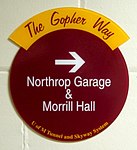University of Minnesota School of Public Health
The University of Minnesota School of Public Health, located in Minneapolis, Minnesota, is a professional school of the University of Minnesota. The school offers 16 masters programs and four doctoral programs, which culminate in one of the following degrees: Master of Public Health (M.P.H.), Master of Healthcare Administration (M.H.A.), Master of Science (M.S.), or Doctoral (Ph.D.). There are also many dual degree programs, such as those with the Law School, the School of Nursing, the Hubert H. Humphrey Institute of Public Affairs and School of Social Work. The School of Public Health was founded in 1944, although public health courses have been offered at the University of Minnesota since its inception in 1874. The School's faculty coordinated the pioneering Seven Countries Study directed by Professors Ancel Keys and Henry Blackburn. U.S. News & World Report consistently ranks the UMN School of Public Health among the top 10 schools of public health in the country. Most recently in 2021, the school was ranked 11th. In 2019, the publication ranked the schools' Healthcare Administration program as #2 in the nation, up from #3 in 2015.
Excerpt from the Wikipedia article University of Minnesota School of Public Health (License: CC BY-SA 3.0, Authors).University of Minnesota School of Public Health
Southeast Harvard Street, Minneapolis
Geographical coordinates (GPS) Address Phone number Website Nearby Places Show on map
Geographical coordinates (GPS)
| Latitude | Longitude |
|---|---|
| N 44.972394 ° | E -93.232864 ° |
Address
University of Minnesota Medical Center East Bank
Southeast Harvard Street 500
55455 Minneapolis
Minnesota, United States
Open on Google Maps






